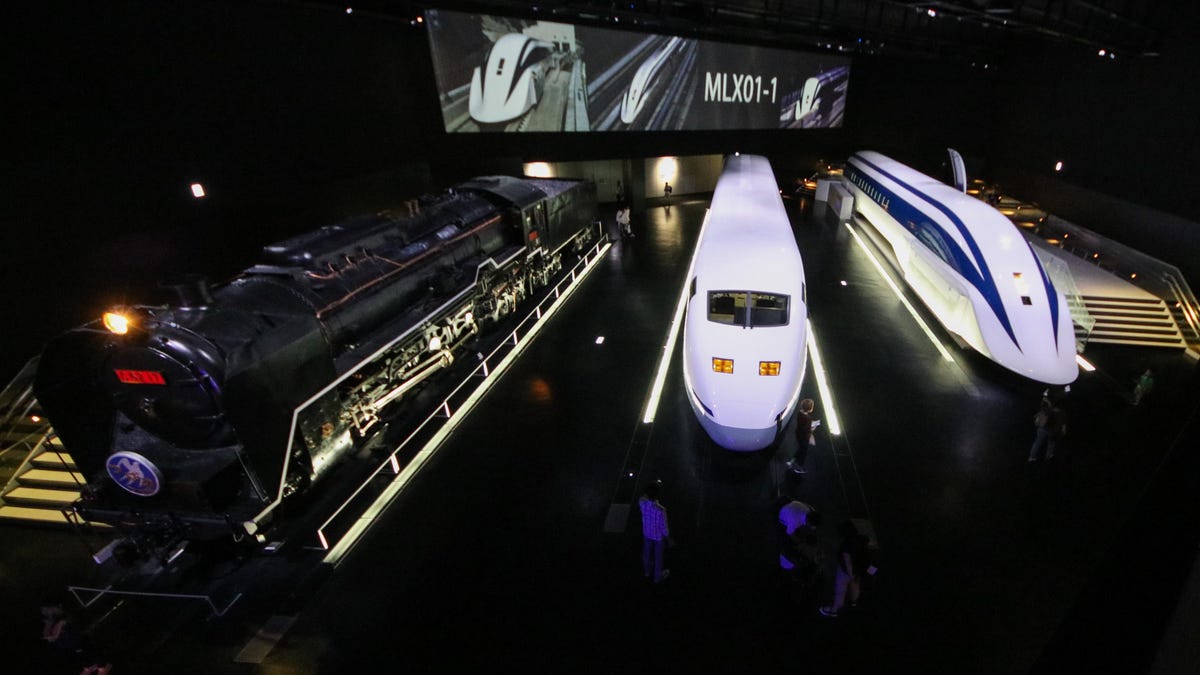 Why You Can Trust CNET
Why You Can Trust CNET Japan's past and future trains float and roll at SCMaglev and Railway Park
Check out the Maglevs, bullet trains, steam locomotives, and more at Nagoya's incredible train museum.

SCMaglev and Railway Park
Maglev sounds as sci-fi as teleporters and hovercars. A train that levitates above a track using electromagnets and cruises at aircraft speeds? That couldn't possibly be a reality. Except it is. China has one that connects Shanghai with its airport and flies along at 268 mph (431 km/h). Japan, seeking to reclaim its crown as the world's leader in amazing train tech, is set to open its own maglev route from Tokyo to Nagoya in 2027.
Yes, open. Not only has the track been built, but they've been testing it for decades. One of the MLX01 maglev prototypes is the jewel of JR Central's train museum in Nagoya. Appropriately called the SCMaglev and Railway Park, it highlights multiple bullet train generations, plus some even older models from Japan's long history of rail travel.
On a recent trip to Nagoya, we decided to have a look.
Magnets!
Maglev is the perfect portmanteau of "magnetic levitation." Using superconducting electromagnets, the train actually hovers slightly above a track, no wheels or rails required. Also using magnets, the train is propelled forward, crazy fast.
The MLX01 looks like a train that's been stretched and pulled to look super aerodynamic. The insides look like an airplane. Smallish windows and seats say "737" more than "train," but this is just the prototype. When this thing enters production in a few years, it's safe to assume that the seats will be as comfortable as the current cabins on shinkansen, Japan's iconic bullet trains.
On closer inspection the weirdness starts to reveal itself. The boxy panels on the side aren't covers for wheels and bogies, because there are no wheels on a maglev. The panels are where the magnets would be and their slightly rough appearance is easily explained by the very nature of being a prototype.
It's easy to imagine this thing zipping along at its intended speed of 315 mph (505 km/h). That's roughly 50% faster than pretty much any regular service high-speed train anywhere.
Getting here from there
While certainly fascinating, the maglev is only one part of the first room of the museum. This room also houses the fastest narrow-gauge steam train, and one of the fastest electric multiple unit trains. It makes for a great juxtaposition of fast trains through the ages.
In the spacious and well-lit main hall, trains are lined up side-by-side, new on the left to old on the right. A Yellow Doctor is a standout here, one of the yellow-painted shinkansen that analyze the tracks and cables to make sure there are no issues or imperfections that would cause serious issues when hit by a few hundred tons of high-speed steel and aluminum. Another rarity is a lavish double-decker shinkansen dining car, right next to the original that still looks fabulously '70s.
An unexpected highlight is the huge model train set that spans from Osaka and Kyoto on one end, Nagoya in the middle, and Tokyo at the other. Not just model trains, but cars and boats move, and timed events happen throughout. On one hand, it's adorable. On the other, it shows an incredible dedication of time and creativity.
This huge model railway covers Osaka to Tokyo and even has a day/night cycle.
Levitating future
Before the shinkansen first opened in the '60s it took nearly 7 hours to get from Tokyo to Osaka by train. The shinkansen made that trip in less than half the time. Decades of improvements mean that now it takes less than 2.5 hours. Not only is the maglev 50% faster than these modern trains, but it will also be taking a new route, almost entirely through tunnels. They're expecting the travel time between these two cities to be just over an hour. That's incredible.
It seems unlikely that all trains of the future will be maglevs. But then again, would the creators of the shinkansen foresee its incredible success not just in Japan, but all over the world? Probably not. For now, though, seeing one of the prototypes next to important high-speed trains through the ages certainly has me interested in a floating future.
Definitely check out the photos above. Maybe they're showing a glimpse at the future... or at least some cool trains of the past.
As well as covering audio and display tech, Geoff does photo tours of cool museums and locations around the world, including nuclear submarines, aircraft carriers, medieval castles, epic 10,000-mile road trips and more.
Also check out Budget Travel for Dummies, his travel book, and his bestselling sci-fi novel about city-size submarines. You can follow him on Instagram and YouTube.

